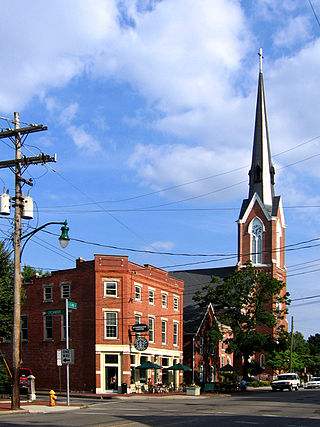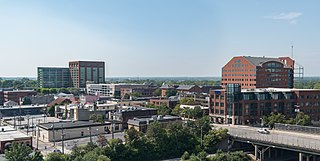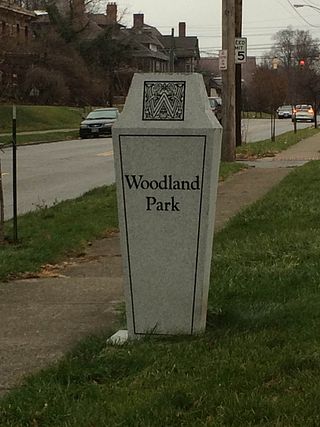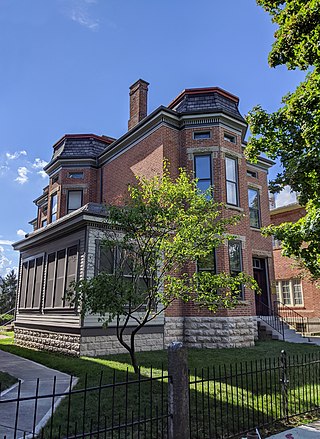Related Research Articles

Columbus is the capital and most populous city of the U.S. state of Ohio. With a 2020 census population of 905,748, it is the 14th-most populous city in the U.S., the second-most populous city in the Midwest after Chicago, and the third-most populous U.S. state capital after Phoenix, Arizona and Austin, Texas. Columbus is the seat of government of Franklin County; it also extends into Delaware and Fairfield counties. It is the core city of the Columbus metropolitan area, which encompasses ten counties in central Ohio. It had a population of 2,138,926 in 2020, making it the largest metropolitan area entirely in Ohio and 32nd-largest metro area in the U.S.

Columbus is a city in, and the county seat of, Bartholomew County, Indiana, United States. The population was 50,474 at the 2020 Census. The city is known for its architectural significance, having commissioned numerous noted works of modern architecture and public art since the mid-20th century; the annual program Exhibit Columbus celebrates this legacy. Located about 40 mi (64 km) south of Indianapolis, on the east fork of the White River, it is the state's 20th-largest city. It is the principal city of the Columbus, Indiana metropolitan statistical area, which encompasses all of Bartholomew County. Columbus is the birthplace of former Indiana Governor and former Vice President of the United States, Mike Pence.

German Village is a historic neighborhood in Columbus, Ohio, just south of the city's downtown. It was settled in the early-to-mid-19th century by a large number of German immigrants, who at one time comprised as much as a third of the city's entire population. It became a city historic district in 1960 and was added to the National Register of Historic Places in 1974, becoming the list's largest privately funded preservation district, and in 2007, was made a Preserve America Community by the federal government. In 1980, its boundaries increased, and today it is one of the world's premier historic restorations.

Victorian Village is a neighborhood in Columbus, Ohio, United States, north and near west of downtown. It is an established neighborhood built when a streetcar line first ran along Neil Avenue around 1900 with a fair number of established trees for an urban setting. To preserve, protect and enhance the unique architectural and historical features, the Victorian Village Historic District was established in 1973. Columbus Monthly named this neighborhood the top place to live for Arts and Entertainment, with fun right around the corner in the Short North as its neighborhood hangout.

The Pontifical College Josephinum is a Roman Catholic seminary and private university in Columbus, Ohio. It was founded by Joseph Jessing in 1888 and was granted the status of a Pontifical College in 1892 by Pope Leo XIII, making it the only pontifical seminary in North America. Although the college is accredited by the Higher Learning Commission (HLC) and Association of Theological Schools in the United States and Canada (ATS), the HLC placed the institution on probation in 2022 for issues including problems in strategic planning, internal leadership structures, and declining enrollment, while the ATS gave a warning for problems in planning.

2 Columbus Circle is a nine-story building on the south side of Columbus Circle in the Midtown Manhattan neighborhood of New York City. The building fills a small city block bounded by 58th Street, Columbus Circle, Broadway, and Eighth Avenue. It was originally designed by Edward Durell Stone in the modernist style for A&P heir Huntington Hartford. In the 2000s, Brad Cloepfil redesigned 2 Columbus Circle for the Museum of Arts and Design (MAD), which has occupied the building since 2008.

North Market is a food hall and public market in Columbus, Ohio. The Downtown Columbus market was established in 1876, and was the second of four founded in Columbus. The market is managed by the non-profit North Market Development Authority (NDMA), which also manages North Market Bridge Park, a market in Dublin, Ohio.

Italian Village is a neighborhood in Columbus, Ohio, that contains an array of residential, commercial, and industrial buildings. It is a designated historic district, known for its historical and cultural preservation. The building types and architecture reflect Italian influence. With its parks and preserved historic homes, Italian Village has the highest home value appreciation in Columbus.
The Near East Side is a neighborhood located near downtown Columbus, Ohio, made up of several neighborhoods: Mount Vernon, King-Lincoln Bronzeville, Eastgate, Franklin Park, Nelson Park, Olde Towne East, and Woodland Park.

The Brewery District, traditionally known as the Old German Brewing District, is a neighborhood located in Columbus, Ohio. Located just south of the central business district and west of German Village, it is bounded by Interstate 70 on the north, South Pearl Street on the east, Greenlawn Avenue on the south, and the Scioto River on the west.
Columbus, the state capital and Ohio's largest city, has numerous neighborhoods within its city limits. Neighborhood names and boundaries are not officially defined. They may vary or change from time to time due to demographic and economic variables.

OhioHealth Riverside Methodist Hospital is the largest member hospital of OhioHealth, a not-for-profit, faith-based healthcare system located in Columbus, Ohio.
South Columbus also referred to as the "South Side" or the "South End", consists of numerous urban and suburban areas south of Downtown Columbus, Ohio, United States. It is part of the native Columbus geographical terminology of the large residential urban communities outside Downtown, including German Village, Schumacher Place, and the Brewery District. South Columbus is defined as the entire southeastern portion of Columbus, bordered by the Scioto River to the west, bounded by Interstate 70 to the north, and includes the southern city limit municipalities beyond the I-270 outerbelt, such as Groveport, Lockbourne, Obetz, and the Rickenbacker International Airport.
The culture of Columbus, Ohio, is particularly known for museums, performing arts, sporting events, seasonal fairs and festivals, and architecture of various styles from Greek Revival to modern architecture.

Woodland Park is a residential neighborhood located in the Near East Side of Columbus, Ohio that houses approximately 1,500 residents. The neighborhood was previously home to such figures as artist Emerson Burkhart, cartoonist Billy Ireland, and judge William Brooks. Established in the early 20th century, Woodland Park has grown from its planned neighborhood roots into a neighborhood that contains various faith communities, schools, sources of entertainment and recreation, and borders an extension of the Ohio State University medical center.

Saint Mary of the Assumption Catholic Church is the third oldest Catholic church building in Columbus, Ohio and is home to an active parish in the Roman Catholic Diocese of Columbus. With the rest of German Village, it was added to the National Register of Historic Places on December 30, 1974.
The Columbus Register of Historic Properties is a register for historic buildings and other sites in Columbus, Ohio, United States. The register is maintained by the City of Columbus Historic Resources Commission and Historic Preservation Office, and was established in 1980. Many of these landmarks are also listed on the National Register of Historic Places, providing federal tax support for preservation, and some are further designated National Historic Landmarks, providing additional federal oversight.

High Street is a major thoroughfare in Central Ohio, predominantly in Franklin County and Columbus. It stretches from the northern border of Columbus in Delaware County south to the southern boundary of Franklin County just past Columbus's municipal boundaries. The street is considered one of Columbus's two main roads, along with Broad Street.

The Columbus Landmarks Foundation, known as Columbus Landmarks, is a nonprofit historic preservation organization in Columbus, Ohio. The foundation is best-known for its list of endangered sites in the city and its annual design award, given to buildings, landscapes, and other sites created or renovated in Columbus. It was established in 1977 as a project of the Junior League of Columbus, Ohio, following the demolition of the city's historic Union Station. It is headquartered at 57 Jefferson Avenue, a contributing structure in the Jefferson Avenue Historic District in Downtown Columbus.

240 Central Park South is a residential building in Midtown Manhattan in New York City. Designed by Albert Mayer and Julian Whittlesey, it was built between 1939 and 1940 by the J.H. Taylor Construction Company, an enterprise of the Mayer family. 240 Central Park South is designed in a combination of the Art Deco, Moderne, and Modern Classical styles, with over 300 apartments.
References
- ↑ "German Village Commission", City of Columbus, Retrieved 29 sept 2009.
- ↑ "German Village Commission". www.columbus.gov. Retrieved 2024-05-29.
